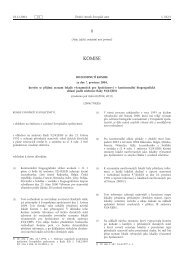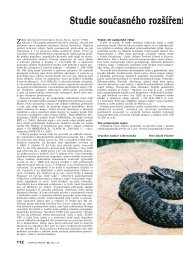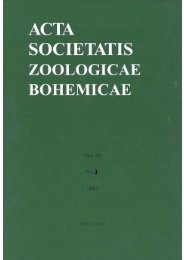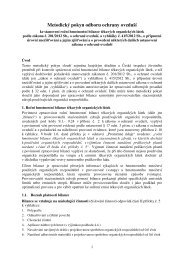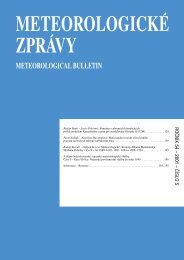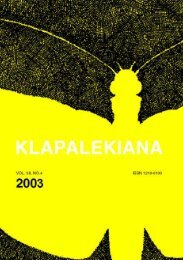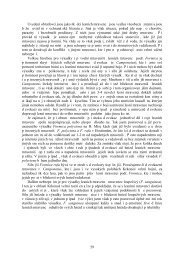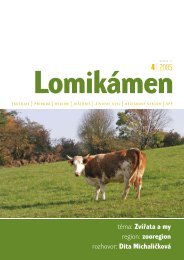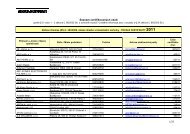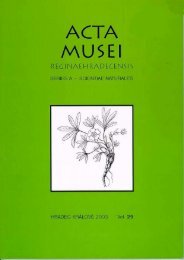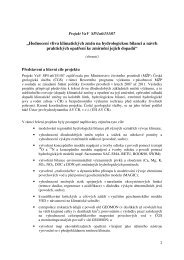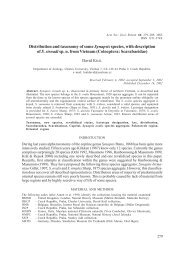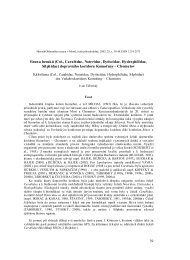journal of forest science
journal of forest science
journal of forest science
Create successful ePaper yourself
Turn your PDF publications into a flip-book with our unique Google optimized e-Paper software.
Prices <strong>of</strong> spruce timber and costs <strong>of</strong> spruce timber logging<br />
V. PETRÁŠOVÁ, J. MECKO, R. PETRÁŠ<br />
Forest Research Institute, Zvolen, Slovak Republic<br />
ABSTRACT: The paper presents detailed analysis <strong>of</strong> price trends <strong>of</strong> spruce timber assortments and the own costs <strong>of</strong> spruce<br />
timber logging in the state <strong>forest</strong>s <strong>of</strong> Slovakia in the period 1988–1997. Besides average prices also variation coefficients<br />
are available. Costs <strong>of</strong> timber logging were analyzed according to the respective logging operations such as felling, skidding,<br />
timber handling and transportation as well as logging related activities. In the period <strong>of</strong> observation the prices <strong>of</strong><br />
spruce timber increased according to assortments 2.7–3.8 times in comparison with 1988. Also the costs <strong>of</strong> spruce timber<br />
logging increased 4.0–5.7 times. The costs <strong>of</strong> timber logging in the period <strong>of</strong> observation were increasing relatively evenly<br />
but the prices <strong>of</strong> timber were increasing mainly until 1992.<br />
Keywords: spruce; assortments; timber price; logging costs<br />
Annual harvest in the Slovak Republic is about 5.5–<br />
5.8 million m 3 <strong>of</strong> timber. Though the tree species composition<br />
<strong>of</strong> felled trees as well assortment composition are<br />
diverse, this volume influences the <strong>forest</strong> sector very significantly,<br />
particularly the <strong>forest</strong> economics. The volume<br />
<strong>of</strong> timber, tree species and assortment composition influence<br />
significantly also the revenues and the costs <strong>of</strong><br />
the economic result. Since 1990 macro-economic conditions<br />
in <strong>forest</strong>ry commercial activities have changed very<br />
importantly. It was particularly in the introduction <strong>of</strong> market<br />
prices for raw timber and competitive environment<br />
on the labour market as well as providing <strong>of</strong> goods services.<br />
Though timber prices have their own importance in<br />
<strong>forest</strong>ry, the issues <strong>of</strong> price formation were not paid appropriate<br />
attention in former Czechoslovakia. It was similar<br />
for the analysis and development <strong>of</strong> price<br />
formation. We can mention from the older publications<br />
the paper by POLENO (1984) dealing with analysis and<br />
prognosis <strong>of</strong> timber price trends, then the papers by<br />
HALAJ et al. (1990) and PETRÁŠ et al. (1992).<br />
After 1990 more marked changes occurred also in the<br />
dynamics <strong>of</strong> trends <strong>of</strong> raw timber prices. orestry circles<br />
responded to this fact, by that time already in the independent<br />
Czech Republic and Slovak Republic, and they<br />
regularly published surveys <strong>of</strong> average prices <strong>of</strong> raw timber<br />
according to the basic quality classes <strong>of</strong> timber. In<br />
the Czech Republic such surveys were published in<br />
Lesnická práce or in the Survey <strong>of</strong> Timber Prices <strong>of</strong> the<br />
Institute for Wood Technology Research and Development<br />
in Prague using the data from the Czech Statistical<br />
Office. The surveys contained average prices from the<br />
JOURNAL O OREST SCIENCE, 47, 2001 (7): 322–330<br />
supplies <strong>of</strong> raw timber to domestic market according to<br />
quality classes for logs, namely quality class I, II, IIIA,<br />
IIIB, IV, V and VI, and main commercial tree species but<br />
also to some neighbouring countries. In the Slovak Republic<br />
a similar survey is being published by the Institute<br />
for orest Management Lesoprojekt Zvolen using statistical<br />
data from statistical reports Les D (Ministry <strong>of</strong> Agriculture<br />
<strong>of</strong> SR) 2-04. This survey is being published for<br />
a higher number <strong>of</strong> tree species than in the Czech Republic,<br />
but quality classes <strong>of</strong> logs IIIA and IIIB are incorporated<br />
into one average price. A shortcoming <strong>of</strong> both<br />
surveys is that they do not contain timber prices according<br />
to diameter classes <strong>of</strong> logs.<br />
Costs <strong>of</strong> spruce timber logging in Slovakia were studied<br />
comprehensively only by HALAJ et al. (1990) and<br />
PETRÁŠ et al. (1992). They studied the costs to express<br />
a net yield <strong>of</strong> value production. They derived an inductive<br />
procedure and constructed the basic algorithm for<br />
the quantification <strong>of</strong> costs <strong>of</strong> the whole logging process.<br />
MATERIALS AND METHODOLOGY<br />
Background data to judge the trend <strong>of</strong> raw timber<br />
prices and the costs <strong>of</strong> its production were obtained from<br />
the statistics <strong>of</strong> state <strong>forest</strong> enterprises in Slovakia for the<br />
years 1988–1997.<br />
TIMBER PRICES<br />
Timber prices were derived according to basic assortments,<br />
it means quality classes <strong>of</strong> logs, namely I, II, IIIA,<br />
IIIB, V and VI quality class, and diameter classes <strong>of</strong> logs<br />
330 J. FOR. SCI., 47, 2001 (7): 322–330



